Our Nordhavn 52 Dirona is far from light at 110,000 lbs but fully laden, the Bell B40D articulating dump truck weights considerably more at 147,000 lbs. Yesterday, I got a chance to drive this six-wheel-drive monster on the Bell Equipment test track. What’s perhaps even more amazing is this is only a mid-sized truck in the Bell Equipment fleet where their largest articulating dump truck, the Bell B60E, is capable of moving more weight than our entire 55-ton boat.

|
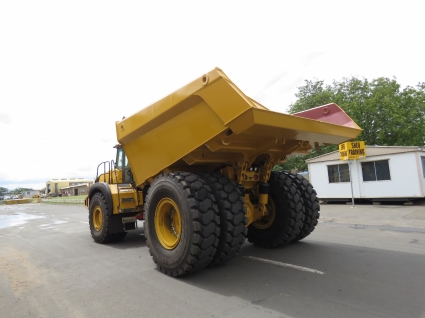
|
What really amazed me is that the B40D I tested is actually remarkably easy to drive even when heading up grades well over 30 degrees. The six-wheel-drive system bites in and just climbs. As the hill gets steeper and wheel spin is just starting, the control systems interupts torque for a few hundred milliseconds, engages the dog clutches to lock up the differentials, and the truck continues up the hill with all 6 wheels locked up for less wheel spin. All shifting and differential lock up is done automaticallly by the Bell proprietary control software. With no experience at all operating heavy equipment, I was able to roar around the track at nearly 34 mph and climb steep dirt grades without any difficulty.
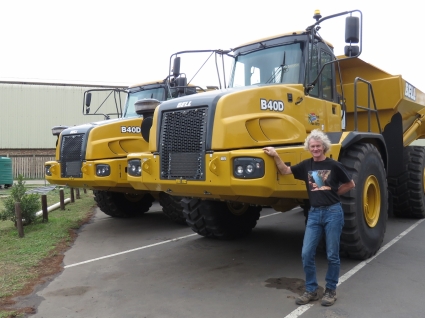
|

|
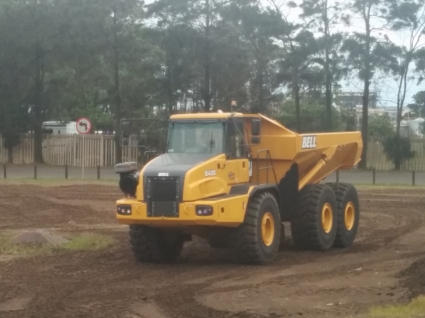
|
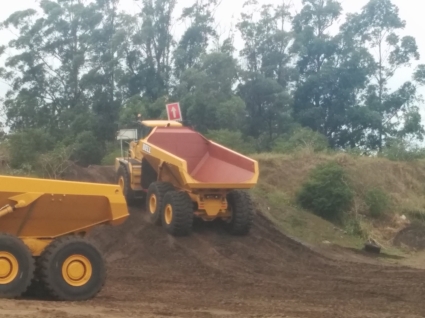
|
The control systems are focused on efficient operation where the lock up differentials are free when they can be, locked up when they need to be, and all shifting of the six- forward-speed transmission is done automatically according to conditions and ensuring that mechanical systems aren’t damaged by overspeed or overload. The control systems know the weight of the load, the weight distribution, the incline the truck is on, the speed, engine output and literally hundreds of other parameters.
When dumping a load, the engine revs come up automatically to deliver the needed hydraulic fluid for a fast dump. And, when re-lowering the empty bin after dump the load, the control systems allow the truck to get back underway as soon as it is again safe for the vehicle to be moving, allowing progressively higher speed as the bin returns to its lowered position after dumping. All designs are focused on making the vehicle as productive as possible in the mine and ensuring the equipment has a long and productive life without complex operator training requirements.
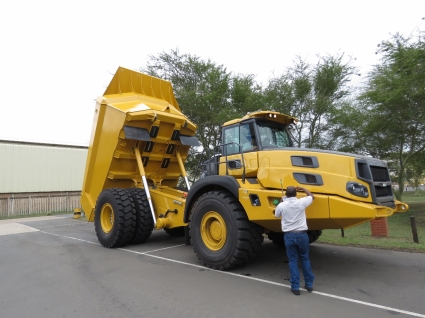
|
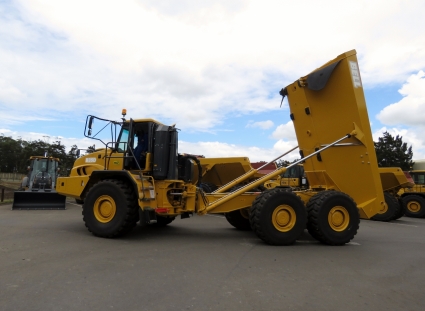
|
We spent the entire day at the Bell Equipment factory in Richards Bay, South Africa and were able to watch the production of these monsters of the mine. It’s a large facility capable of turning out 2,000 trucks at maximum production rate. It’s amazing to watch raw steel sheets arive at the facility, be descaled in a sand blaster and then lifted in by crane and lowered down onto laser, plasma, or oxyacetelene cutting tables. All the plate cuttters are Computer Numerically Controlled where designs go directly from the Computer-Aided Design (CAD) systems used by the designers directly to the CNC cutting tables. I’ve seen large CNC laser cutters in the past but none this big.
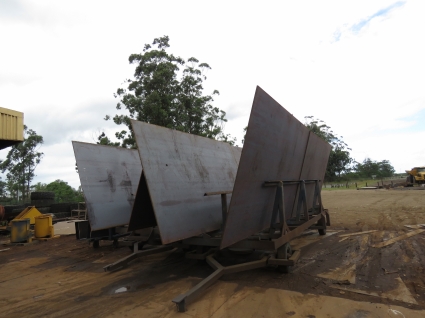
|
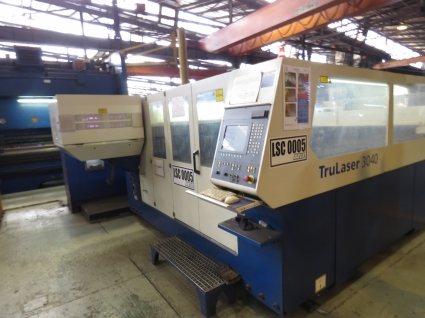
|
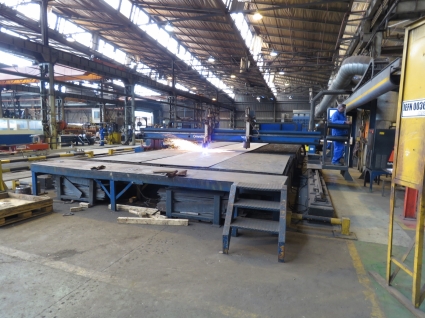
|
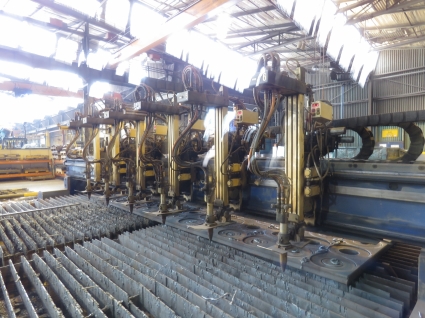
|
Once the steel is cut, it is craned off the cutters and dopped down into jigs for welding. The welding is inert gas shielded and the beads are near perfect. The trick to the high quality welding is partly a well-trained team but a part of the secret is placing the work so it can be comfortably welded. Running high-quality beads certainly can be done upside down but it’s much more difficult. Instead, the work itself is on hydraulic rotathors and the welders have stable platforms that can be moved directly to the work. They do use some robotics welders but most are done by hand and the quality is uniform across the board with all welds smooth and well-penetrated.
The welded chassis components are assembled in the same facilty and all mechanical systems are installed and tested before spending time on the test track and ensuring all tests pass before being shipped to mines all over the world.
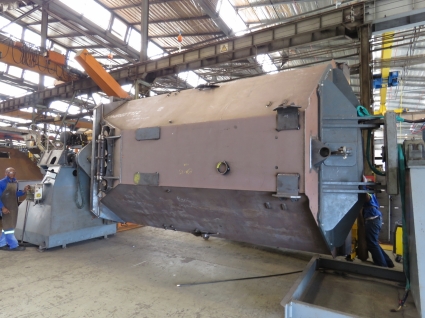
|

|
After spending a good part of the day in the factory and on the test track, we then went to the control systems development office were the software is written that makes these monsters easy and efficient to drive and helps keep fleet operators informed on where their trucks are, how productive each truck is, and the exact conditions each truck are operating under.
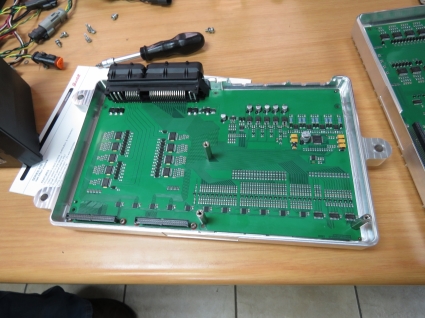
|
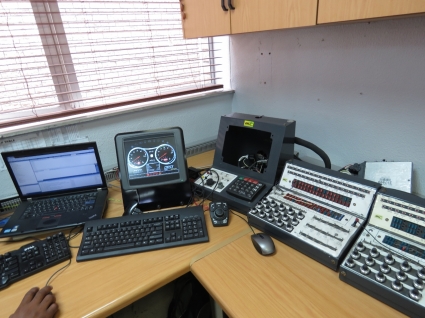
|
The internet of things has become a popular topic in the news of late but Bell Equipment has been doing this since since 2008 when the first versions of there newest control and tracking systems were first released. All trucks are fully instrumented where the load weight, number of dumps, fuel consumption, engine load, which operator is at the wheel, and literally 100s of other parameters are all tracked in near real time. All the data is sent by satelite or, if available, GSM cellular connection back to the factory. This data is available for customers to run reports and to track their fleet focusing on different metrics of interest. The data allso is used by Bell Equipment to improve designs and to focus their development efforts on features that actually solve problems in the mines their customers are operating. This leads to better designs, more reliable systems, and higher fleet utilization. If you like data and extracting value from data as much as I do, you’ll know why this visit was a real treat.
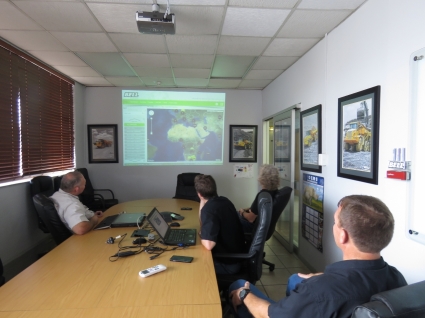
|
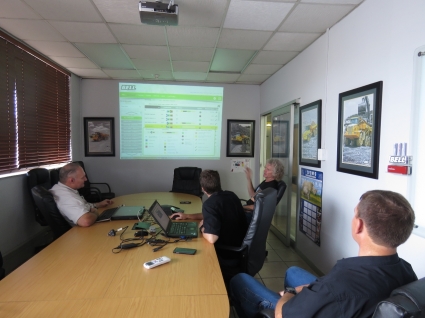
|
Thanks to Gary Bell (CEO), Pieter Goosen (Director of Engineering), Eben Lemmer (Electrical Manager), Deon Joubert (Product Designer), Laurika Martyn (Personal Assistant to CEO), and everyone on the Bell Equipment team that were kind enough to answer a steady stream of questions as we passed through. And thanks to Keith Harvey of the Richards Bay Industrial Development Zone for introducing us to Bell Equipment.

|
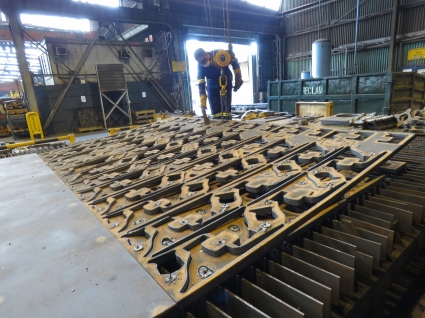
|
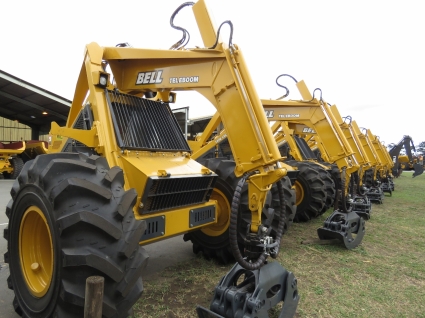
|
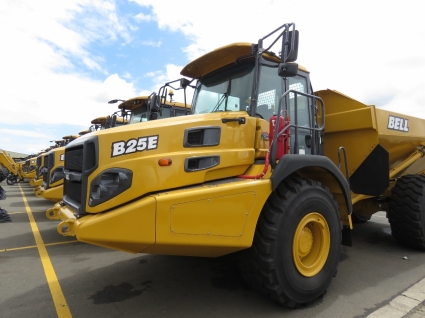
|




Seeing you like heavy equipment, I’ll have to let you drive some stuff around at our shop when you get over this way.
I’m looking forward to learning more about the heavy equipment you have around the office Oliver. When it comes to technology, there isn’t much we aren’t interested in so, be careful, we might take you up on your offer of a visit.
James the ironic part is that most of our stuff is pretty old school, just old manual gauges that never work and buzzers that never seem to stop for no reason. Lol, we do have 5 Mack Dump trucks that’s are relatively new though.
Oliver said “old manual gauges that never work and buzzers that never seem to stop for no reason” :-). Love it!
Thanks for sharing that tour of the Bell factory. Amazing seeing how those monster trucks are made. Must have taken a crowbar to get you out of that rig you were driving. Looked like a ton of fun!
100% right Stewart. Whenever there is this much technology in one place, it’s hard to leave.
Man, knowing you, I can feel your elation half a world away!??
You are so right Jacques. It’s hard to beat 415 hp screaming below as you pilot a 6 wheel drive monster up what feels like a nearly vertical dirt wall.
I just love technology and much of what it enables.
Interesting factory tour! I’m addicted to your adventures. Thanks for sharing. If there was a market for mass produced steel hull boats, that rotating jig would be the way to build them. Very interesting how technology is tracking 100s of parameters in off-road equipment, but in aviation, regulatory and certification issues keep us in the stone age.
You may be correct that regulation may have slowed innovation in Aviation Gary but, for sure, the track-everything mentality is absolutely comming to aviation as well. Modern jet engines are already heavily tracked and GE and others have big plans to add more quickly. It totally makes sense. Any time you have a high value asset, more information can help utilize the equipment better, avoid dangerous or high wear operating modes, know when operators need more training, and help customers track and schedule maintenance. We’ll see it first in highly expensive gear like jet engines and mining equipment, in large over the road truck fleets, and in the marine industry. But, these same approaches are going to migrate down to even inexpensive devices. Software is at the core of everything.
Jennifer, James
It was such a treat meeting you and showing you the things we geek out with at our dayjobs. I wish there was more time to pick your brains.
May Zululand and Richards Bay leave a lasting impression on your hearts. It’s a pity you are experiencing it during this raging drought.
May we meet again (in a raining season)
Deon
It was good meeting you as well Deon. My belief has long been that software is the core enabler and differentiator for absolutely all products from Airplanes to refridgerators and you folks are showing it’s true of heavy equipment as well.
When worrying about the weather, remember I was born in Victoria Canada and have lived much of my life in the Pacific North West. Your bad weather is better than our good weather. We’re having a great time in the Richards Bay, Zululand area. Thanks for the hospitality.
Pretty cool stuff there. Trucks in dirt never get boring no matter what age your at. :)
You are right Tim. We don’t really have space for an articulating dump truck on Dirona but I’m starting to think we really need one :-).